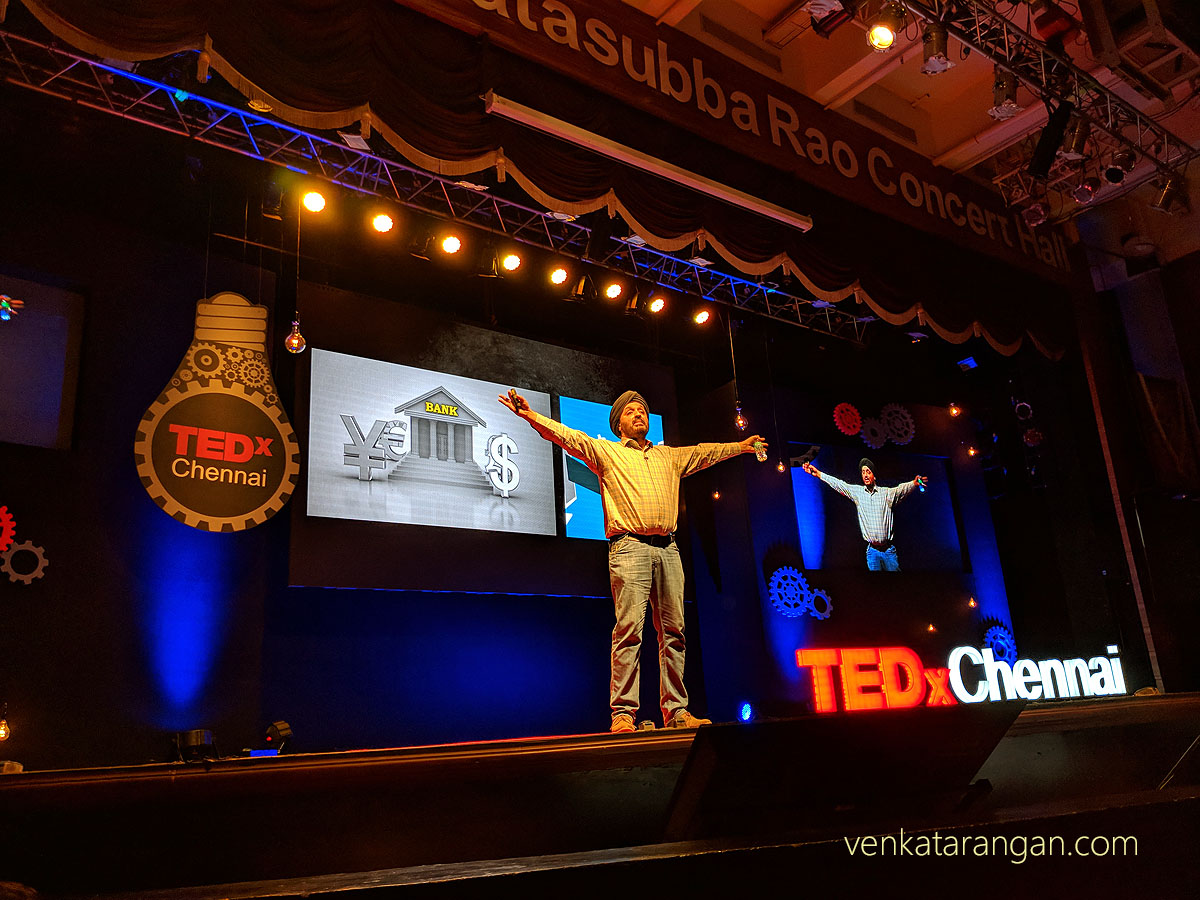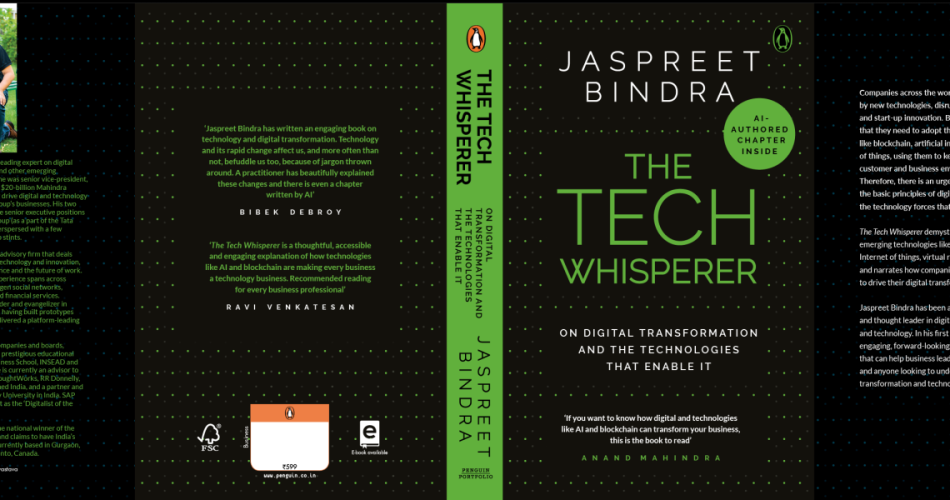I know Mr Jaspreet Bindra from his days with Microsoft India where he was heading the MSN India Portal; over the years I am happy to have him as a well-wisher and friend. Jaspreet is one of those business leaders who see technology as only a solution to a problem but on how it can help customers and increase business value. In his last role, he was the Vice-President at the Mahindra Group, India leading their digital transformation efforts – not an easy task considering Mahindra is a $20 billion conglomerate with interest across industries including Automotive, Agriculture, Defence, Finance, Retail, Hospitality and many more.

Jaspreet Bindra at the TEDxChennai 2018
In his informative talk at TEDxChennai 2018, he had shared many case-studies of transformation projects he was working on, it was obvious a book on the subject will give him the space to elaborate on the subject.
The Book – The Tech Whisperer
I attended the launch of Mr Jaspreet Bindra’s record-smashing book “The Tech Whisperer” in Chennai on the 29th November 2019 – the book is published by Penguin India. It is about Digital Transformation and The Technologies that enable it. I read the book last month, once I started, I had to finish it in one go, it was that engaging.
The book is a good read for both the engineers who are working on the technologies like AI, ML, IoT, Blockchain, RPA and many others that are powering Digital Transformation and, for the Executives who are heading businesses that need to be transformed to stay competitive and lead their industries. For the former, it provides the context on the solutions they are building using the technologies and a better understanding of the prevailing business climate they are operating. For the latter, the book provides an appreciation of the underlying technologies and a demystification of the jargons, helping them to communicate better with their engineering team.
“The most powerful person in the world is the storyteller. The storyteller sets the vision, values and agenda of an entire generation that is to come” – Steve Jobs
Jaspreet writes the following paragraph in the introduction: “We live in a cacophonous world. We look at our phone more than 2000 times every day, to try and take in the half a million tweets, the hundred thousand Instagram photos, 50 million WhatsApp messages which are sent every minute … and somewhere in the middle of all of this, a human being who actually wants to talk to you! As each of them tries to grab your attention, they try and shout louder and louder, they blink, they pop-out, they transform themselves into emojis… In this cacophonous word, I believe that a whisper can be heard far more loudly than a scream. Therefore, I have dredged into my experience and scoured the world to collect all these whispers.”
In the first chapter of the book Mr Bindra explains what is Digital Transformation?, what ‘Born Digital’ companies do differently to traditional businesses, and, closes with explaining three catatonic forces affecting the automobile industry.
In the next chapter, he has codified based on his experience of helping companies, The Ten Commandments of Digital Transformation, starting with “Leadership Vision and Commitment” and ending with “Patience” to see through the journey. The chapter includes portions from his interview with Dr George Westerman, the principal research scientist on Digital Economy at the MIT Sloan Institute and the author of the well-known work “Leading Digital: Turning Technology into Business Transformation“.

Digital Transformation – Fashionistas, Digital Masters, Beginners, Conservatives
The next three chapters talk of The Holy Trinity (like in the Hinduism’s Brahma, Vishnu and Shiva) of Digital Transformation: Business Models being the Brahma, the creator; Customer Experience is Vishnu, the Preserver; and the People and Culture are Shiva, the Destroyer. For explaining the various models, Mr Bindra uses the 19 Business Models created by Mr Mark W. Johnson, and, explains the importance of platforms to building a highly scalable model. Mr Bindra also quotes one of his favourite examples of Trringo built by his former employer (Mahindra & Mahindra) – which was an ‘Uber’ for Tractors.

The 19 Types of Business Models from “Reinvent your business model” by Mark W Johnson
When the author talks about Customer Experience, The Vishnu, he explains the importance of Customer Journey and Customer Journey Maps – a good one should include Personas, Timeline, Emotion, Touch-Points and Channels. The last of the trinity, The Shiva is all about People & Culture, as a leader to build a digital culture amongst many things mentioned in the book you need to be innately curious & do not fear failure, and, to be radically transparent.
The author then takes us through How to Digitally Transform your legacy company with explanations for the BCG’s head-heart-hands framework and McKinsey’s ten guiding principles of a Digital Transformation.

Ten Guiding Principles of Digital Transformation
Mr Bindra then talks in detail about his favourite subject, Blockchain, what it is and how it can change everything (Your Business, Your Country and Your Life). He proceeds with explaining why Data is the ‘New Oil’, the three Vs of Volume, Velocity and Variety to remember when handling Big Data, and, often neglected but more important type of data, Small Data.
Printed with Green colour edges, the distinctive-looking chapter was a special one for the book – the 40 pages titled “An AI Writes on AI” was generated by a machine learning program FP-Summary from Findability Sciences Platform for writing the text for the chapter. The chapter talked about the origins of AI, (surprise) it started way back in 1308 when a Catalan Poet & Theologian Ramon Llull publishes his “Ars Generalis Ultima” a paper-based mechanical means to create new knowledge from combinations of concepts.
Then in the 1950s, the fathers of the field Minsky and McCarthy described Artificial Intelligence as any task performed by a program or a machine that, if a human carried out the same activity, we would say the human had to apply intelligence to accompish the task
The book ends with a chapter outlining the various other technologies in the horizon starting with IoT, Robots, Robotic Process Automation (RPA), Drones, 3D Printing, VR & AR – the author ends with an example of how Mahindra was using VR to provide test drive of a car to a customer at her home.
Overall, this is a must-read on the subject, check it out.



Comments